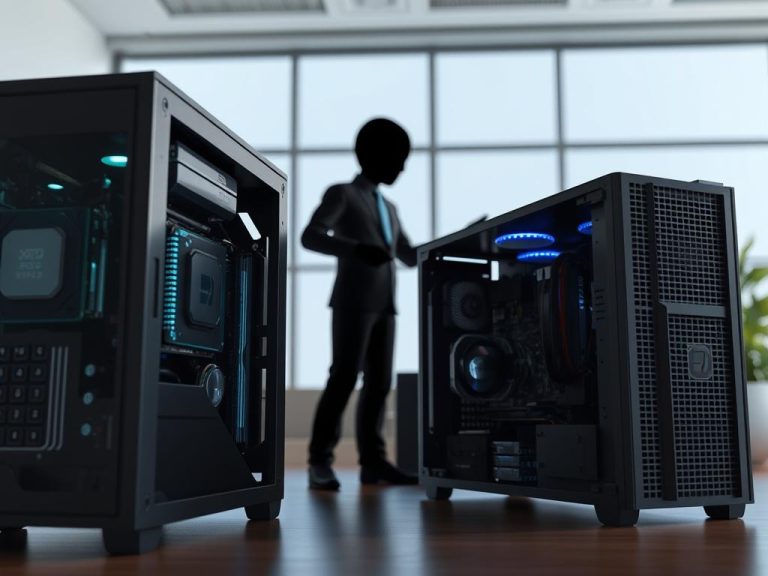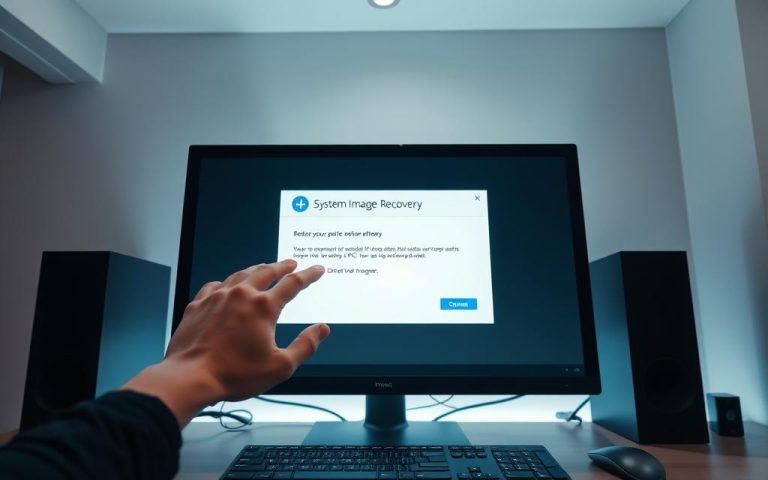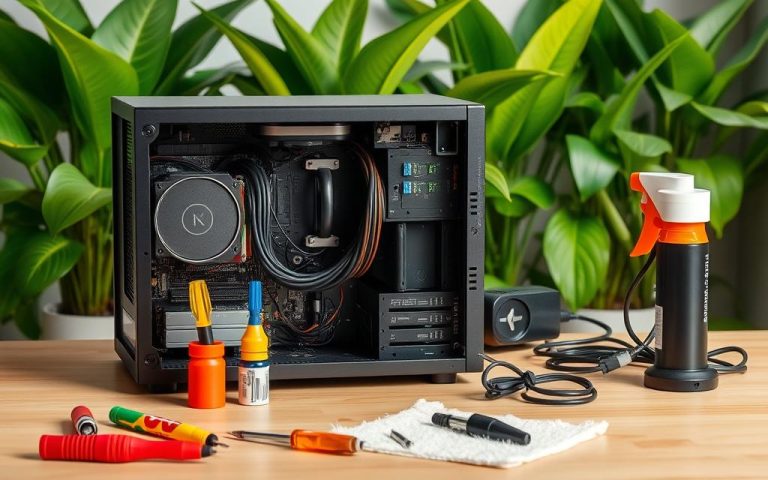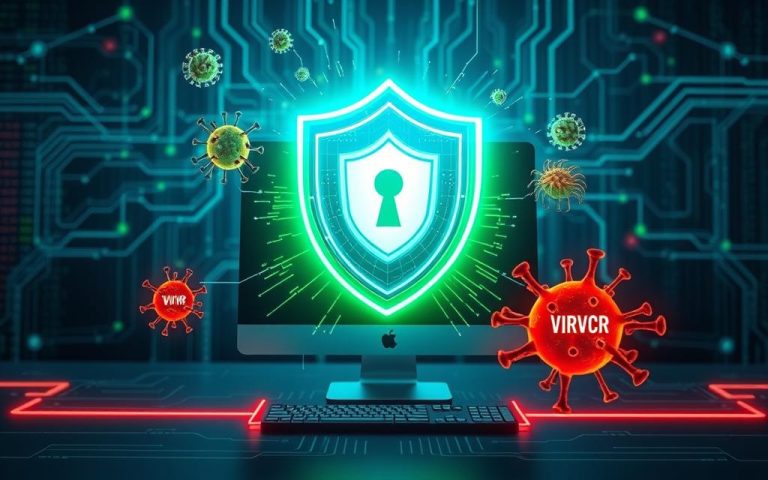How to Switch Operating Systems on Your Computer: A Step-by-Step Tutorial
Switching your computer’s operating system can seem scary. But it’s often needed because of compatibility issues, security worries, or wanting new features. Changing your operating system can make your computer feel new again. We’ll show you how to do it, with help from top experts.
There are many operating systems to choose from, like Windows 10, Ubuntu Linux, and Mac OS Catalina. Before you switch, make sure to back up your important files. This way, you won’t lose anything important. Tools like EaseUS Todo Backup Home can help you back up your files, systems, and partitions safely.
Understanding Operating Systems and Their Compatibility
When you think about getting a new OS, it’s key to know the basics. You need to look at features, how well it works with other stuff, security, and support. It’s also important to check if your hardware and software will work with it.
Choosing an OS depends on many things. Like what you like, what your computer needs, and how you plan to use it. For example, knowing about operating systems helps you pick between Windows, macOS, or Linux. Each has its own look, how it works with software, and security.
Important things to think about for compatibility include:
- Hardware needs: Like how fast your processor is, how much RAM you have, and how much disk space you need
- Software compatibility: Making sure your apps work with the new OS
- Security features: Looking at the safety features each OS has
Operating system compatibility is key for a smooth change. Knowing about operating systems and their compatibility helps you choose wisely. This knowledge makes switching to a new OS easier and less stressful.
Essential Preparations Before Switching Your Operating System
Getting ready is crucial for a smooth switch. First, back up important files, documents, and settings. Use an external hard drive or cloud service to keep them safe. Data backup is vital in system preparation to protect your valuable information.
Plan your system preparation well. Look into any software or hardware you might need for the new OS. Check if your current devices and programs work with it. This helps avoid problems and makes the transition easier.
Important things to think about for data backup and system preparation are:
- Identifying critical files and documents to back up
- Choosing a reliable backup method, such as external storage or cloud services
- Researching compatible software and hardware for the new operating system
- Creating a plan for transferring settings and configurations to the new OS
By following these steps and focusing on data backup and system preparation, you can make your OS switch successful and stress-free.
Backing Up Your Important Data and Creating Recovery Points
Before you switch to a new operating system, backing up your important data is key. This helps prevent loss and makes the transition smoother. You can store your files on an external hard drive or in the cloud. Data backup and recovery solutions are vital to protect against data loss.
The 3-2-1 rule is a good way to back up your data. It means having 3 copies, on 2 different types of storage, and 1 offsite. External hard drives and cloud services like Google Drive and Dropbox are great for this.
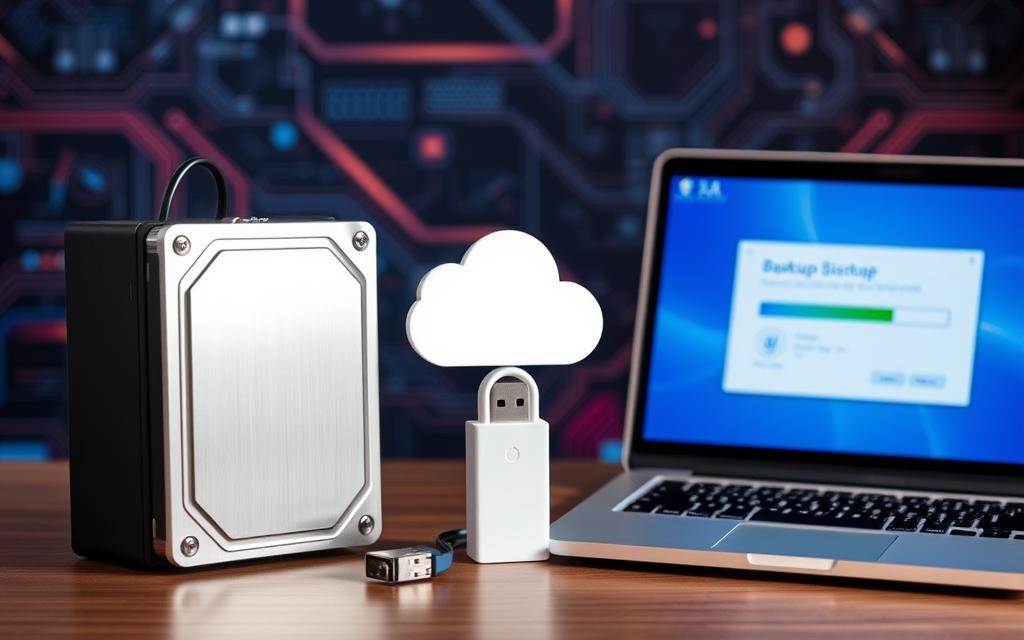
When picking a backup solution, think about security and how easy it is to use. Cloud storage services use encryption and passwords to keep your data safe. Also, consider the cost and how easy it is to recover your data if needed. A good backup solution keeps your data safe and reduces the risk of loss.
Creating System Image Backups
System image backups are a detailed way to back up your data. They capture everything on your system, including your operating system and settings. This is especially useful when you switch to a new operating system, as it lets you go back to a previous state if needed.
Cloud Storage Solutions
Cloud storage is a handy and secure way to back up your data. Many services offer automatic backups and syncing in real-time. When choosing a cloud storage solution, think about the security, ease of use, cost, and how it scales.
How to Change the Operating System of a Computer
Changing a computer’s operating system can seem hard, but it’s easier with the right help. There are many ways to install a new operating system, each with its own pros and cons. One common choice is the dual-boot setup, which lets you use more than one operating system on one computer.
A dual-boot setup means making separate areas on your hard drive for each operating system. It needs careful planning but lets you easily switch between systems. For instance, you might want to use both Windows and Linux, switching between them as needed.
Methods for Changing the Operating System
- Clean Installation: This method involves completely erasing the existing operating system and installing a new one from scratch.
- Dual-Boot Setup: This method involves creating separate partitions for each operating system, allowing users to switch between them as needed.
- Virtual Machine Installation: This method involves installing a new operating system within a virtual machine, allowing users to run multiple operating systems simultaneously.
When picking a way to install a new operating system, think about what you need. A dual-boot setup is great for those who use more than one system. But if you want a clean start, a clean installation might be better. Always back up your data and make a recovery disk or restore point to make the change smooth.
Installing Windows on Your Computer
When you start with Windows installation, it’s key to do it right. First, get the Windows media from Microsoft’s site or buy a physical copy. Then, make a bootable USB with at least 5GB free space.
Next, plug in the USB and restart your computer. It will boot from the USB. Follow the on-screen steps to set up Windows. You’ll choose your language, agree to terms, and pick how to partition your hard drive.
Here’s what you need to do for a good operating system setup:
- Download the Windows media and make a bootable USB.
- Plug in the USB and restart your computer.
- Follow the on-screen steps in the Windows wizard.
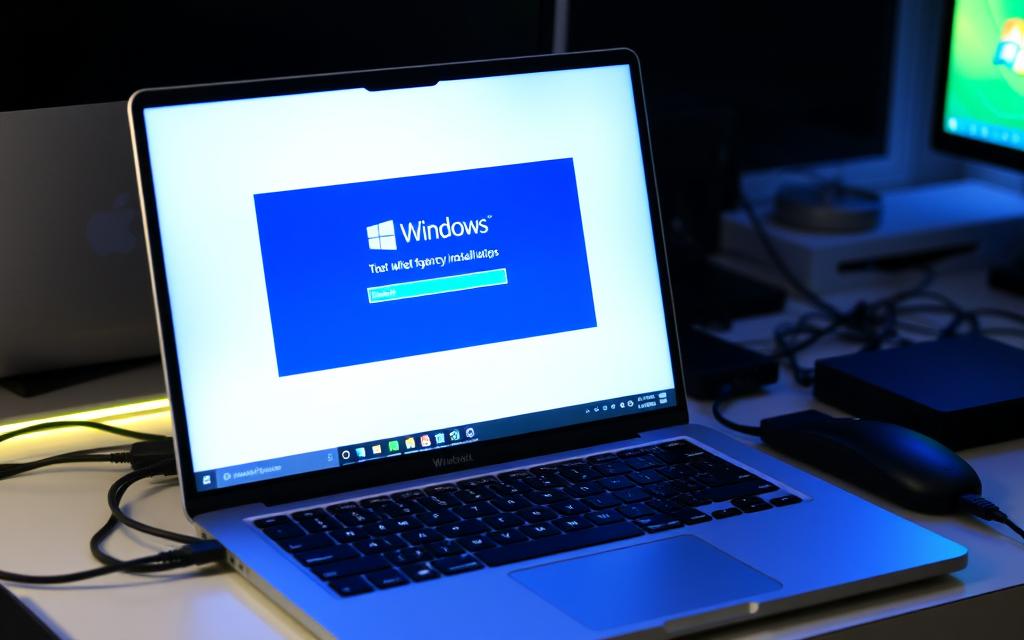
The whole process usually takes about 20 minutes. This time can vary based on your computer’s speed and the Windows version. By following these steps, you can set up Windows smoothly.
| Windows Version | Installation Time | Minimum System Requirements |
|---|---|---|
| Windows 10 | 20 minutes | 2GB RAM, 20GB free space |
| Windows 7 | 30 minutes | 1GB RAM, 15GB free space |
Transitioning to macOS: Requirements and Process
Switching to macOS? First, check if your device is compatible. Look at your Mac’s specs or compatible hardware. This ensures it can handle the latest macOS. A smooth macOS installation is key for a hassle-free switch.
Start by backing up your data and making a bootable installer. Then, use the macOS installer to set up the OS. After that, set up your user account, connect to Wi-Fi, and update your software.
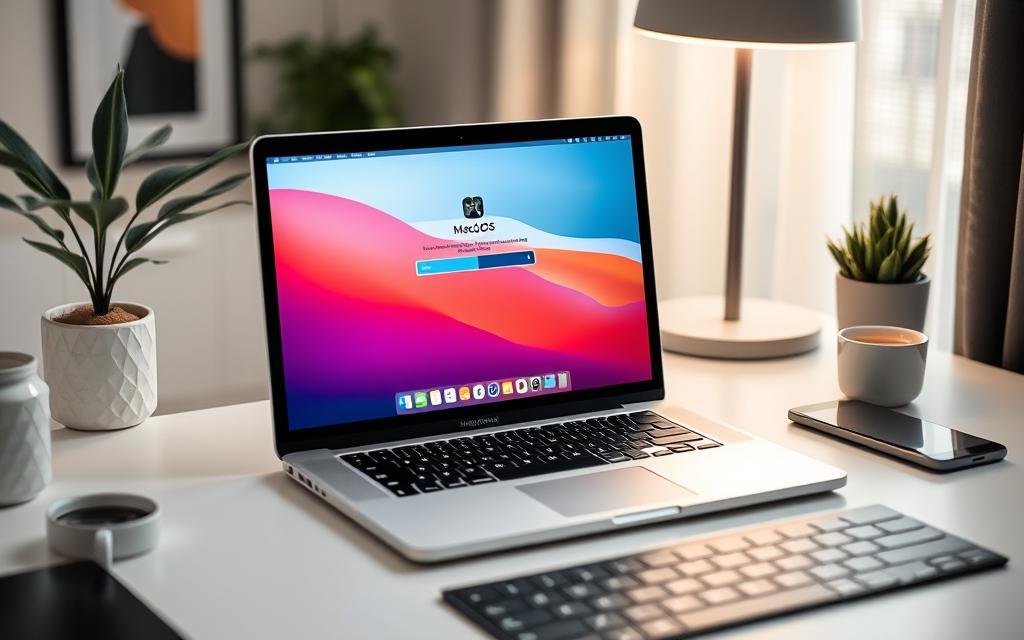
Explore features like the Finder and Spotlight search. These help you get around your new macOS device easily.
Try macOS on a virtual machine or live USB first. This checks if your hardware is compatible and makes the installation smoother.
Linux Installation Guide and Distribution Selection
Choosing the right Linux distribution is key. There are over 600 active distributions, like Ubuntu, Debian, and Fedora. Each has special features, so pick one that fits your needs.
Ubuntu is great for new users because it’s easy to use and well-supported. Arch Linux is good for those who like to customize. Think about your hardware, software needs, and community support when picking.
Some top Linux distributions are:
- Ubuntu: known for its user-friendly interface and extensive support
- Debian: a stable and secure distribution with a large community
- Fedora: a distribution that offers the latest software packages and a strong focus on community involvement
After picking a distribution, start the Linux installation. First, make a bootable USB drive. Then, boot from it and follow the installation wizard. It will help you set up your system, including choosing languages and creating accounts.
Once installed, you can dive into your new Linux system. With the right distribution selection and a smooth Linux installation, you’ll have a stable, secure, and customizable OS.
| Distribution | Description |
|---|---|
| Ubuntu | User-friendly interface, extensive support |
| Debian | Stable and secure, large community |
| Fedora | Latest software packages, strong community involvement |
Troubleshooting Common Installation Issues
Installing a new operating system can sometimes go wrong. You might face boot problems, driver issues, or slow performance. But, most problems can be fixed with some troubleshooting.
Look out for signs like the blue screen of death, failing to boot, or sudden shutdowns. These can be due to hardware problems, driver issues, or damaged files. Try booting in safe mode, running a virus scan, or using tools like Fixboot and Sfc.
Other issues might include compatibility problems, slow performance, or trouble opening files. Fix these by updating your system, keeping security patches current, and scanning for malware. Sometimes, you might need to reinstall the OS or get help from experts.
- Check for hardware malfunctions or damaged device drivers
- Run a virus scanner to detect and remove malware
- Use troubleshooting tools such as Fixboot, Fixmbr, and Sfc
- Update system components and ensure security patches are up to date
- Reinstall the operating system if necessary
| Issue | Solution |
|---|---|
| Boot problems | Boot in safe mode, run a virus scanner, or use troubleshooting tools |
| Driver compatibility issues | Update device drivers or reinstall the operating system |
| System performance concerns | Update system components, ensure security patches are up to date, and scan for malicious software |
By following these steps and using the right tools, you can fix common installation problems. Troubleshooting can be tricky, but with the right approach, you can enjoy a smooth OS experience.
Post-Installation Steps and System Optimisation
After installing a new operating system, it’s key to follow some important steps. These include updating the system, removing unwanted programs, and installing needed software and drivers. Customizing settings like power options and display settings can also boost performance and security.
Experts say it’s 100% recommended to update the system to the latest version. This brings new features, bug fixes, and security patches. It’s also 100% advised to remove programs you don’t need. This improves system performance and security.
Here are some essential post-installation steps to consider:
- Install reliable antivirus software to protect against viruses and malware.
- Defragment the disk, especially for HDD storage units, to enhance system performance.
- Backup your data using cloud storage or external hard drives for safety.
By taking these steps, you can make sure your new operating system runs smoothly.
| Post-Installation Steps | System Optimization Benefits |
|---|---|
| Update operating system | Latest features, bug fixes, and security patches |
| Remove unwanted programs | Optimize system performance and security |
| Install antivirus software | Protect against viruses, malware, and other threats |
Conclusion: Best Practices for a Successful Operating System Switch
Switching your operating system can open up new possibilities. It can also make your computer work better. As you finish moving to a new OS, remember a few key tips.
Start by getting to know your new OS. Look at its features and how it works. Learn the shortcuts that make things easier. Knowing your OS well will help you get the most out of it.
Also, use online resources and talk to the community. There are many forums and tutorials out there. They can help you solve problems and find cool features. Talking to others can also give you tips to make your system run smoothly.
Starting this new journey, stay positive and be open to learning. Changing your OS might take some getting used to. But, you’ll soon see the benefits like better security and more apps. It’s all worth it.
FAQ
What are the main reasons for switching operating systems?
People switch operating systems for a few main reasons. These include problems with compatibility, worries about security, and a desire for new features or a different way of using the computer.
What are the common operating system options available?
There are a few common operating systems out there. Windows, macOS, and Linux distributions like Ubuntu, Fedora, and Debian are popular choices.
What are the hardware requirements for different operating systems?
The hardware needs for operating systems differ. You’ll need to check if your computer’s processor speed, RAM, and disk space match the system’s requirements before switching.
Why is it important to back up data before switching operating systems?
Backing up your data is key before switching operating systems. It ensures your files, documents, and settings are safe and can be recovered if needed.
What are the methods for backing up data before switching operating systems?
There are a few ways to back up your data. You can create system image backups, use cloud storage, or external storage devices.
What are the different methods for changing the operating system on a computer?
There are a few ways to change your computer’s operating system. You can do a clean install, set up a dual-boot, or use a virtual machine.
What are the key steps for installing Windows, macOS, and Linux on a computer?
Installing each operating system has its own steps. You’ll need to download the installation media, create bootable media, and follow the on-screen instructions.
How can common installation issues be troubleshooted?
Troubleshooting common installation problems is possible. You can address boot issues, driver problems, and performance concerns by following specific steps and workarounds.
What are the essential post-installation steps and system optimisation techniques?
After installing, there are important steps to take. You should update your system, install necessary software and drivers, and configure settings. Also, don’t forget to add security measures for the best performance and upkeep.










